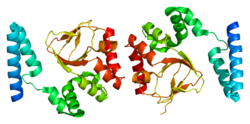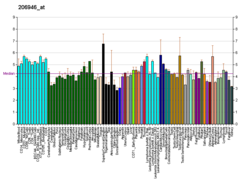Potassium/sodium hyperpolarization-activated cyclic nucleotide-gated channel 4 is a protein that in humans is encoded by the HCN4 gene.[5][6][7][8]
There are four HCN channels. HCN4 is prominently expressed in the pace maker region of the mammalian heart.[9] Some humans with bradycardia and Sick sinus syndrome have been shown to have mutations in their HCN4 gene.[10][11][12] The role of HCN channels in autonomic control of heart rate is currently a matter of ongoing investigation.[13][14][15][16]
- ^ a b c GRCh38: Ensembl release 89: ENSG00000138622 – Ensembl, May 2017
- ^ a b c GRCm38: Ensembl release 89: ENSMUSG00000032338 – Ensembl, May 2017
- ^ "Human PubMed Reference:". National Center for Biotechnology Information, U.S. National Library of Medicine.
- ^ "Mouse PubMed Reference:". National Center for Biotechnology Information, U.S. National Library of Medicine.
- ^ Ludwig A, Zong X, Stieber J, Hullin R, Hofmann F, Biel M (May 1999). "Two pacemaker channels from human heart with profoundly different activation kinetics". The EMBO Journal. 18 (9): 2323–9. doi:10.1093/emboj/18.9.2323. PMC 1171315. PMID 10228147.
- ^ Seifert R, Scholten A, Gauss R, Mincheva A, Lichter P, Kaupp UB (Aug 1999). "Molecular characterization of a slowly gating human hyperpolarization-activated channel predominantly expressed in thalamus, heart, and testis". Proceedings of the National Academy of Sciences of the United States of America. 96 (16): 9391–6. Bibcode:1999PNAS...96.9391S. doi:10.1073/pnas.96.16.9391. PMC 17793. PMID 10430953.
- ^ Hofmann F, Biel M, Kaupp UB (Dec 2005). "International Union of Pharmacology. LI. Nomenclature and structure-function relationships of cyclic nucleotide-regulated channels". Pharmacological Reviews. 57 (4): 455–62. doi:10.1124/pr.57.4.8. PMID 16382102. S2CID 45853869.
- ^ "Entrez Gene: HCN4 hyperpolarization activated cyclic nucleotide-gated potassium channel 4".
- ^ Baruscotti M, Bucchi A, Viscomi C, Mandelli G, Consalez G, Gnecchi-Rusconi T, Montano N, Casali KR, Micheloni S, Barbuti A, DiFrancesco D (Jan 2011). "Deep bradycardia and heart block caused by inducible cardiac-specific knockout of the pacemaker channel gene Hcn4". Proceedings of the National Academy of Sciences of the United States of America. 108 (4): 1705–10. Bibcode:2011PNAS..108.1705B. doi:10.1073/pnas.1010122108. PMC 3029742. PMID 21220308.
- ^ Jou, Chuanchau J.; Arrington, Cammon B.; Barnett, Spencer M; Shen, Jiaxiang; Cho, Scott; Sheng, Xiaoming; McCullagh, Patrick C.; Bowles, Neil E.; Pribble, Chase M.; Saarel, Elizabeth V.; Pilcher, Thomas A.; Etheridge, Susan P.; Tristani-Firouzi, Martin (2017). "A Functional Assay for Sick Sinus Syndrome Genetic Variants". Cellular Physiology and Biochemistry. 42 (5): 2021–2029. doi:10.1159/000479897. ISSN 1015-8987. PMID 28803248.
- ^ Schulze-Bahr E, Neu A, Friederich P, Kaupp UB, Breithardt G, Pongs O, Isbrandt D (May 2003). "Pacemaker channel dysfunction in a patient with sinus node disease". The Journal of Clinical Investigation. 111 (10): 1537–45. doi:10.1172/JCI16387. PMC 155041. PMID 12750403.
- ^ Laish-Farkash A, Glikson M, Brass D, Marek-Yagel D, Pras E, Dascal N, Antzelevitch C, Nof E, Reznik H, Eldar M, Luria D (Dec 2010). "A novel mutation in the HCN4 gene causes symptomatic sinus bradycardia in Moroccan Jews". Journal of Cardiovascular Electrophysiology. 21 (12): 1365–72. doi:10.1111/j.1540-8167.2010.01844.x. PMC 3005590. PMID 20662977.
- ^ Larsson HP (Sep 2010). "How is the heart rate regulated in the sinoatrial node? Another piece to the puzzle". The Journal of General Physiology. 136 (3): 237–41. doi:10.1085/jgp.201010506. PMC 2931147. PMID 20713549.
- ^ Schweizer PA, Duhme N, Thomas D, Becker R, Zehelein J, Draguhn A, Bruehl C, Katus HA, Koenen M (Oct 2010). "cAMP sensitivity of HCN pacemaker channels determines basal heart rate but is not critical for autonomic rate control". Circulation: Arrhythmia and Electrophysiology. 3 (5): 542–52. doi:10.1161/CIRCEP.110.949768. hdl:11858/00-001M-0000-002C-5DAB-C. PMID 20693575.
- ^ Liao Z, Lockhead D, Larson ED, Proenza C (Sep 2010). "Phosphorylation and modulation of hyperpolarization-activated HCN4 channels by protein kinase A in the mouse sinoatrial node". The Journal of General Physiology. 136 (3): 247–58. doi:10.1085/jgp.201010488. PMC 2931151. PMID 20713547.
- ^ Nof E, Antzelevitch C, Glikson M (Jan 2010). "The Contribution of HCN4 to normal sinus node function in humans and animal models". Pacing and Clinical Electrophysiology. 33 (1): 100–6. doi:10.1111/j.1540-8159.2009.02563.x. PMC 2865562. PMID 19796353.





